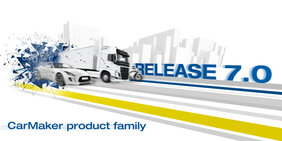Detailed sensor models, RDE-compliant emissions tests, the option of parallel simulation of countless test kilometers on high-performance computing clusters, and more than 400 new 3-D objects to design the virtual test environment – these are some of the major updates that the release 7.0 of the CarMaker product family by IPG Automotive offers for virtual test driving. Particularly in the fields of virtual prototypes and automotive systems engineering, the Karlsruhe-based company has expanded its products that enable cross-domain testing in areas such as the development of advanced driver assistance systems and automated driving functions, powertrains, or vehicle dynamics systems. The company thus continues to support users in meeting the current challenges of the industry.
The fast and detailed transfer of realistic test scenarios including the entire environment into the virtual world with powerful real-time capable models for the vehicle, road, driver and traffic is the core competency of the simulation solutions of the CarMaker product family. The new release has now opened up the possibility of using the products for parallel simulation on several processors or processor cores. High-performance computing (HPC) clusters as well as HPC Light now enable even faster testing on high-performance PCs due to distributed computing. For vehicle development which involves a high number of scenarios to be validated, particularly for advanced driver assistance systems or automated driving functions, the use of such high-performance computers entails a massive reduction of computing time and therefore savings in time and costs. The release 7.0 makes it possible to use the open integration and test platform CarMaker on HPC clusters and drive countless test kilometers in the virtual world. “There are two requirements for a simulation environment to enable parallelized testing of extensive scenarios – stability and a low additional effort involved in the parallelization. This requires a software architecture that accommodates the requirements and the setup of HPC clusters. The better these requirements are met, the greater the acceleration will be that can be achieved through parallelization. With the release 7.0, the integration and test platform CarMaker provides this architecture and is therefore ideally suited for this specific purpose,” summarized Andreas Höfer, Product Manager Simulation Software at IPG Automotive.
Realistic and automated Real Driving Emissions testing
The new RDX Test Generator for propulsion system development enables the automated generation of a multitude of realistic test cycles for the evaluation of Real Driving Emissions (RDE) as well as energy and fuel consumption, and the use of these test cycles in virtual test driving. Taking adjustable driver behavior and traffic density into account, the test scenarios are generated and may be reproducibly used for propulsion system optimization.
With the new product variant CarMaker/TestBed, the experts at IPG Automotive cater specifically to users in the field of propulsion system development on dynamometers. “Our latest product is also a commitment to this market in terms of delivering optimally adjusted, comprehensive and industrialized simulation solutions. With CarMaker/TestBed, component test beds become system test beds which enable the efficient and seamless testing of the interplay between virtual and real prototypes on dynamometers. Possible fields of application can be summarized under the keywords RDE, virtual electrification, smart durability testing, attribute balancing and functional testing,” said Felix Pfister, Business Development Manager Powertrain at IPG Automotive.
Real-time capable sensors deliver extensive environment data
IPG Automotive took another great leap forward in the field of real-time capable modeling and generation of raw sensor signals. The new Ultrasonic RSI and Radar RSI models complement the portfolio of sensor models of the CarMaker product family. The raw signal interfaces serve to model detailed physical effects and thus open up the possibility of developing sensor fusion algorithms in the virtual world, for instance. Whether the focus is on testing the perception or on decisions to be made, thanks to a comprehensive environment recognition precise driving actions derived from this are possible.
New look for data analysis
The data analysis tool IPGControl presents itself with a new design and even more features. A new data source panel comprises a snapshot tool for a quick comparison of two test runs, for example, and the general option of displaying more than one source at a time. There is also a mouse-controlled zoom function and the possibility to automatically restore the last session.
Even more detailed and realistic environment generation
Particularly in the areas of driver assistance and automated driving, the modeling of complex traffic scenarios in virtual test driving plays a crucial role. The Scenario Editor enables the fast and efficient generation of detailed scenarios. Its latest additions include a new path and route concept, maneuver-based lane switching as well as a flexible placement of traffic on all lanes. Others are a streamlined route definition and dynamic traffic path planning. The ease of use of the editor was refined again as well.
Even more detailed scenarios are now possible with an array of more than 90 new vehicles (passenger cars, trucks, motorcycles, vans), 170 new types of buildings (row houses, office and industrial buildings, American suburban houses) and vegetation. The NCAP soft targets are now also included.
With these and many other new features of the release 7.0, the solution provider IPG Automotive will continue to supply a highly efficient tool for its customers. Throughout every stage of the development process, it enables extensive tests in virtual test driving in line with the current challenges of the industry long before real prototypes are available.
